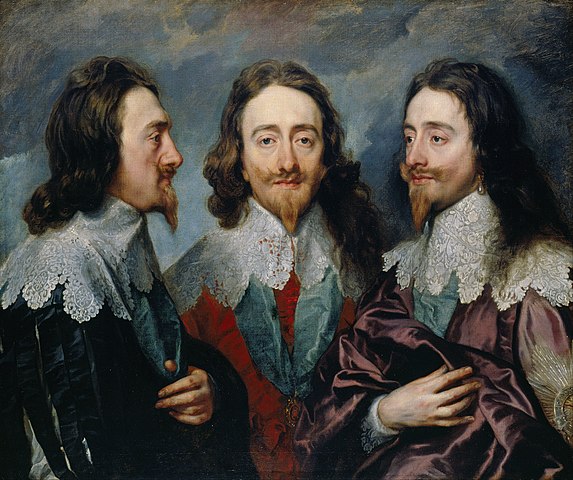
Title: Charles I in Three Positions
Artist: Anthony van Dyck
Date Painted: 1635-1636
Medium: Oil on Canvas
Dimensions: 99.4cm x 84.4cm
Period: Baroque
Location: Windsor Castle, Berkshire, UK
Summary of Charles I in Three Positions
Charles I in Three Positions is a famous portrait by the Flemish artist Anthony van Dyck, painted in 1635 or 1636. The painting, also known as “Triple Portrait of Charles I,” features King Charles I of England, Scotland, and Ireland depicted in three different angles: front, profile, and three-quarter views. This masterpiece was created during the period of Charles I’s reign, which is marked by the tension between the monarchy and Parliament, eventually leading to the English Civil War.
The purpose behind this triple portrait was practical: it was intended to be sent to Rome so that the Italian sculptor Gian Lorenzo Bernini could create a marble bust of Charles I without the king having to travel. The painting, therefore, had to provide Bernini with a thorough understanding of the king’s appearance from multiple angles.
Van Dyck’s work showcases his mastery in capturing the dignity and elegance of his subjects. Each of Charles I’s poses reveals different aspects of his personality and status. The front view shows the king facing the viewer directly, conveying his royal authority and composed demeanor. The profile view emphasizes the king’s nobility and the lineage that comes with his royal blood, while the three-quarter view offers a more nuanced and personal glimpse of Charles, suggesting the depth of his character.
The painting is remarkable for its detail, color, and the skill with which Van Dyck portrays textures, from the king’s intricate lace collar and silk sash to his flowing hair. The use of light and shadow enhances the three-dimensional quality of the figure and imbues the portrait with a sense of life.
Charles I in Three Positions is not only a brilliant example of portraiture but also serves as an insightful historical document. It reflects the artistry of Van Dyck, considered one of the most prominent court painters of his time, and his ability to capture the essence of his subjects. Additionally, the painting offers a glimpse into the political and cultural context of 17th-century England and its monarchy.
Today, the painting is held in the Royal Collection and is esteemed not only for its artistic value but also for its historical significance, illustrating the relationship between art and power in the early modern period. The bust by Bernini, unfortunately, was destroyed in a fire in the 18th century, making Van Dyck’s painting an even more precious record of the intended collaboration between two of the most celebrated artists of their time.